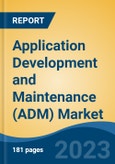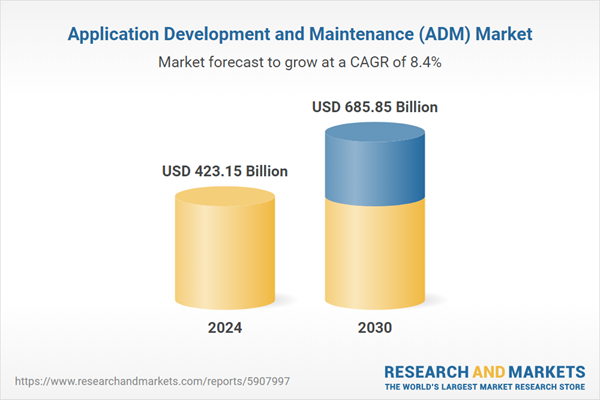Speak directly to the analyst to clarify any post sales queries you may have.
10% Free customizationThis report comes with 10% free customization, enabling you to add data that meets your specific business needs.
As digital transformation accelerates across sectors such as healthcare, banking, retail, manufacturing, and government, organizations increasingly rely on application ecosystems to streamline operations and deliver superior customer experiences. The growing complexity of IT infrastructure, combined with the shift to multi-cloud and hybrid environments, is driving the need for robust ADM solutions. Companies seek development models that support agility, scalability, and rapid time-to-market, often turning to microservices, DevOps, containerization, and low-code platforms. This demand has been further fueled by the need for remote operations, automation, and cybersecurity resilience in the post-pandemic era.
Key Market Drivers
Accelerating Digital Transformation Across Industries
The rapid pace of digital transformation is reshaping the enterprise technology landscape. Businesses across sectors are revamping their traditional operations through cloud computing, artificial intelligence, Internet of Things, and mobile platforms. These transformations require sophisticated application environments that support real-time decision-making, customer engagement, and operational agility. As a result, enterprises are investing heavily in the design, development, and deployment of custom software solutions to support their digital-first strategies.Transformation does not end at application launch - it requires continuous upgrades, security patches, performance monitoring, and user experience enhancement. The Application Development and Maintenance (ADM) Market benefits directly from these needs. ADM services enable businesses to scale flexibly, improve time-to-market, and enhance customer satisfaction through robust, agile, and resilient applications. This ongoing support model is key to sustainable transformation in finance, manufacturing, logistics, and other sectors. According to the World Economic Forum’s 2024 Digital Readiness Index, over 72% of global enterprises reported accelerated digital transformation efforts post-pandemic, with enterprise-grade application platforms being ranked among the top three investment priorities, indicating direct alignment with Application Development and Maintenance (ADM) Market growth.
Key Market Challenges
Legacy Infrastructure and Technical Debt
A persistent challenge in the Global Application Development and Maintenance (ADM) Market is the burden of legacy infrastructure and the resulting technical debt. Many enterprises continue to rely on outdated systems that were developed decades ago using obsolete programming languages and platforms. These legacy applications are often deeply embedded in the organization’s operational and financial workflows, making them difficult and risky to replace or modernize. As digital transformation initiatives accelerate, these systems become significant roadblocks to innovation. Maintaining them requires specialized skills that are increasingly scarce, leading to inflated maintenance costs, operational inefficiencies, and security vulnerabilities. Moreover, legacy systems lack compatibility with emerging technologies like artificial intelligence, machine learning, and cloud-native environments, further impeding the organization’s agility and scalability.In the context of ADM services, the presence of legacy systems often complicates project scopes, increases time-to-market, and limits the flexibility of new application deployments. Application development teams must expend considerable effort and resources in reverse engineering outdated codebases, understanding undocumented features, and ensuring integration with modern APIs and platforms. This technical debt diverts focus from innovation to remediation, significantly affecting the value proposition of ADM services. Even with strategic modernization initiatives, enterprises frequently face internal resistance, budgetary constraints, and risk aversion, which delay or derail transformation efforts. As such, ADM vendors are compelled to design hybrid service models that balance modernization with continuity, adding complexity to their service delivery and costing structures.
Key Market Trends
Rise of Low-Code and No-Code Development Platforms
The Global Application Development and Maintenance (ADM) Market is undergoing a significant transformation with the increasing adoption of low-code and no-code platforms. These platforms empower business users and non-technical professionals to participate actively in the application development process, reducing dependency on specialized developers. Enterprises are leveraging these platforms to accelerate time-to-market, enhance agility, and address the growing demand for customized digital solutions without incurring excessive development costs. This democratization of software creation is particularly beneficial in rapidly evolving industries where the ability to launch and iterate applications quickly can deliver competitive advantages.As the demand for digital solutions outpaces the supply of skilled developers, organizations are turning to low-code and no-code tools to bridge this gap. These platforms are being integrated with artificial intelligence and machine learning features, further enhancing their capabilities and appeal. They allow organizations to streamline workflows, reduce the burden on IT departments, and improve collaboration between business and technical teams. This trend is expected to continue reshaping the dynamics of the Application Development and Maintenance (ADM) Market, especially in sectors like banking, healthcare, and retail, where agility and digital customer engagement are paramount.
Key Market Players
- Accenture plc
- IBM Corporation
- Tata Consultancy Services Limited
- Infosys Limited
- Cognizant Technology Solutions Corporation
- Capgemini SE
- Wipro Limited
- HCL Technologies Limited
Report Scope:
In this report, the Global Application Development and Maintenance (ADM) Market has been segmented into the following categories, in addition to the industry trends which have also been detailed below:Application Development and Maintenance (ADM) Market, By Service:
- Management
- Maintenance
- Modernization
- Development
- Quality Service
Application Development and Maintenance (ADM) Market, By Vertical:
- IT & Telecom
- BFSI
- Healthcare
- Retail
- Manufacturing
- Government
- Others
Application Development and Maintenance (ADM) Market, By Region:
- North America
- United States
- Canada
- Mexico
- Europe
- Germany
- France
- United Kingdom
- Italy
- Spain
- Asia Pacific
- China
- India
- Japan
- South Korea
- Australia
- Middle East & Africa
- Saudi Arabia
- UAE
- South Africa
- South America
- Brazil
- Colombia
- Argentina
Competitive Landscape
Company Profiles: Detailed analysis of the major companies present in the Global Application Development and Maintenance (ADM) Market.Available Customizations:
With the given market data, the publisher offers customizations according to a company's specific needs. The following customization options are available for the report.Company Information
- Detailed analysis and profiling of additional market players (up to five).
This product will be delivered within 1-3 business days.
Table of Contents
Companies Mentioned
- Accenture plc
- IBM Corporation
- Tata Consultancy Services Limited
- Infosys Limited
- Cognizant Technology Solutions Corporation
- Capgemini SE
- Wipro Limited
- HCL Technologies Limited
Table Information
| Report Attribute | Details |
|---|---|
| No. of Pages | 180 |
| Published | August 2025 |
| Forecast Period | 2024 - 2030 |
| Estimated Market Value ( USD | $ 423.15 Billion |
| Forecasted Market Value ( USD | $ 685.85 Billion |
| Compound Annual Growth Rate | 8.3% |
| Regions Covered | Global |
| No. of Companies Mentioned | 8 |









